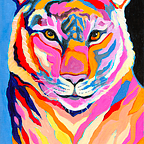5G networks are expected to roll out as soon as 2021, delivering significantly higher download speeds and lower latency to mobile users worldwide. The introduction of 5G will facilitate advancements in augmented reality and catalyze its wide-scale adoption, promising new opportunities for high-fashion retailers.
What is AR?
Augmented reality (AR) lays a digital augmentation over one’s surroundings. It differs from virtual reality, which replaces a user’s environment with an interactive computer-generated world. Currently, AR can best be incorporated into everyday life with smartphone cameras, but it will likely be applied to contact lenses and virtual retinal displays in the near future.
AR uses technologies like SLAM (simultaneous localization and mapping), depth tracking, and computer vision. It relies on a cloud computing connection in which low latency (provided by a 5G connection!) allows the retrieval of high-resolution images from the cloud — this is essential to achieve realistic, life-like AR on mobile devices.
Even if AR seems like a foreign concept to you, odds are you’ve actually used it before. Remember Pokémon GO? Incase you don’t (where were you in 2016?), elusive game creatures projected over a user’s camera screen gave the appearance that Pikachu and the gang were in one’s real-life surroundings. It wasn’t an unusual sight to come across children (and adults) stumbling through their neighborhoods, immersed in their devices in the pursuit of Pokémon.
Now that so many people are familiar with basic AR (75% of daily Snapchat users interact with AR lenses), software engineers are experimenting more with utility-based AR. While we anticipate the roll-out of 5G, NOW is the time for the high-fashion industry to embrace AR.
The brutally competitive fashion e-commerce scene has sent brands racing to introduce creative applications of technology to their marketing strategies. After a disappointing fourth quarter in 2019, retailers faced an even tougher period at the beginning of 2020 as in-store shopping further declined. With the halt of in-person sales altogether due to COVID-19, rich online experiences are crucial for retailers to survive these tumultuous times. Fortunately, AR is here to help.
How Do Luxury Companies Use AR?
With social media as the top way millennials discover new luxury brands, recent collaborations between tech and fashion giants have unsurprisingly garnered positive feedback. During the 2019 holiday season, Ralph Lauren partnered with Snapchat to introduce an AR-enhanced game featuring their iconic Polo Bear. Alongside the game, Snap Ads promoted clothing from their Holiday Collection with direct access to the RL website. Users who engaged with both the game and the Snap Ads generated a remarkable 19% lift in web sales.
Following this successful implementation of AR, Ralph Lauren and Snapchat have partnered again to debut a Wimbledon-themed lens using ground segmentation technologies. Users have the options to play an interactive tennis game with the Polo Bear and shop the RL 2020 Wimbledon capsule collection. Although the tournament has been cancelled due to COVID-19, this virtual experience promises to deliver a dose of tennis to one’s very own living room.
Burberry claims they are “continuously experimenting with digital innovation such as AR to create a more exciting experience and enhance personalized luxury commerce.” This past February, they created an AR shopping tool with Google. A simple search for the “Burberry Black TB bag” or the “Arthur Check Sneaker” yields a 3D-overlay of the mentioned product over one’s surroundings. Instead of introducing this technology through an app or the Burberry website, partnering with Google helps reach a wider audience and offers extreme ease of use — all one has to do to activate this feature is click a “View in 3D” button.
Gucci first incorporated AR into its marketing strategy by partnering with Wannaby, a technology company. In 2019, they added a shoe try-on feature to the Gucci app, allowing users to virtually sport different models of the bestselling Ace sneaker.
In June, Gucci launched the first ever try-on AR Snapchat lens to again allow users to try on four different models of sneakers. It also offers options to upload a shot to social media and directly purchase the shoes. According to their CEO Marco Bizzarr, mastering the balance between tech and art has allowed Gucci to capture the attention (and $!) of Gen-Z and Millennials. Despite these demographics traditionally being difficult for expensive luxury brands to capture, 62% of Gucci’s 2018 sales came from those under the age of 35.
Snapchat isn’t the only platform where AR lenses have gained popularity. A spokesperson for Dior explained that Instagram filters “can also be tried by someone who sees a friend using it on Instagram Stories, which means Instagram AR filters are basically designed to go viral. They represent a huge growth opportunity.”
Since 2018, Dior has released various Instagram filters showcasing their sunglasses, headbands, and makeup.
Cool… Can I Make AR?
Good question — yes, you can! Snapchat uses Lens Studio to create all of the AR filters we see on the app. With tutorials, templates, and options to incorporate more advanced concepts like machine learning with SnapML, Lens Studio offers abundant opportunity regardless of one’s CS background. Go give it a try — AR is the future!
